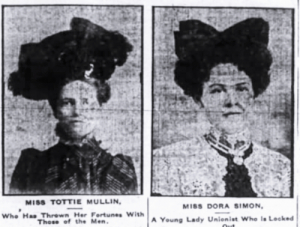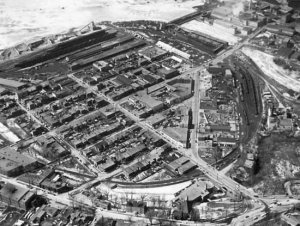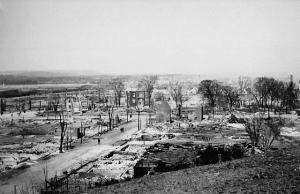The Eddy Lock-out
11 January 1904
The great fire of 1900, which gutted most of Hull and LeBreton Flats in Ottawa, destroyed much of E.B. Eddy’s paper works located near the Chaudière Falls. However, within six months of the disaster, the eponymous E.B. Eddy Company was back in operation thanks in no small measure to the iron determination of its owner.
Ezra Butler Eddy was a man of many parts—a self-made entrepreneur, philanthropist, politician and church-going Presbyterian. By the early 1900s, his firm employed more than 2,000 people in his pulp, paper, and match empire. His paper and fibre products were sold across the Dominion. He owned exclusive cutting privileges to more than 1,000 square miles of timber land in the region. At various times, he was mayor of the City of Hull, and member of the Quebec legislature for the county of Ottawa. In other words, he was a powerful man.
He was also as hard as nails. He had to be to get to where he was in the rough and tumble lumber business. He ran his company accordingly. By his lights, he was a fair man, giving employment to the people of the region and paying competitive wages. His company was an “open shop,” hiring union and non-union men to run the paper-making machines. Eddy said he had nothing against unions. He was probably telling the truth, being a proud, honorary member of the Ottawa Bricklayers’ Union, an accolade he received after the great fire.
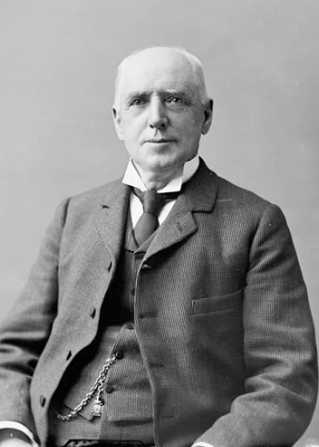 Ezra Butler Eddy, Topley Studios, Library and Archives Canada, 3468801.In addition to E.B. Eddy’s iron will, the quick recovery of his factories after the 1900 fire was also due to the hard work of his employees. They laboured long hours, longer than they had prior to the fire. The mills were in operation from Monday morning at 7:00 am to Sunday morning at 5.30 am. There were only two shifts. The day shift ran 78 hours per week, the night shift 65 hours. The men alternated shifts, sharing the difference in hours. On average, the men worked approximately twelve hours per working day, six days out of seven. There was no break for meals. By June 1901, the men had had enough. They wanted shorter hours with the same pay. Eddy refused, claiming losses sustained in the fire as the reason. The issue of shorter hours was put on the back-burner.
Ezra Butler Eddy, Topley Studios, Library and Archives Canada, 3468801.In addition to E.B. Eddy’s iron will, the quick recovery of his factories after the 1900 fire was also due to the hard work of his employees. They laboured long hours, longer than they had prior to the fire. The mills were in operation from Monday morning at 7:00 am to Sunday morning at 5.30 am. There were only two shifts. The day shift ran 78 hours per week, the night shift 65 hours. The men alternated shifts, sharing the difference in hours. On average, the men worked approximately twelve hours per working day, six days out of seven. There was no break for meals. By June 1901, the men had had enough. They wanted shorter hours with the same pay. Eddy refused, claiming losses sustained in the fire as the reason. The issue of shorter hours was put on the back-burner.
About this time, the International Brotherhood of Papermakers set about organizing the Eddy workers. In 1902, the local branch of the union asked for shorter hours for Eddy’s papermakers. Again, the company said no since it would mean the loss of 50-60 tons of paper per week. Mr. Eddy also claimed that his company was already paying its employees the “highest wages going.” However, after lengthy negotiations, the company agreed to give shorter hours a “fair trial,” staring in January 1903. On average, the workers would work eleven hours per day for the same pay. The mills would close at 5.30 pm on Saturday. There was a catch however. According to Mr. Eddy, workers would have to become more productive, offsetting the lost production owing to the shorter hours. The workers said they would try their utmost to do so.
Initially, all seemed to go well. During the summer of 1903, Eddy appeared satisfied with his employees’ effort. But then things began to sour. A demand by workers for a pay increase was rejected. Instead, Eddy informed them that unless production increased during the remainder of the year, the short-hour system would be discontinued.
At the beginning of January 1904, paper mill superintendents gathered their men and read them the bad news which was contained in a circular to all employees. The circular claimed that average daily output through the previous year had been neither what the workers had promised, nor what the company had expected. Consequently, the hours of employment would henceforth run from Monday, starting at 6.30 am, until midnight Saturday.
There had been no consultation or discussion with the union, or mill workers at large. With only two shifts, this change increased the average work week by roughly thirty minutes to 11 ½ hours. Eddy also urged papermakers to “try in every way to bring it [output] up to what it should be for the wages paid, the class of machinery installed and the facilities we have.” Wages for men in the plant ranged from $1.25 per day to $3.25 per day. Most were at the lower end of the scale. In contrast, top corporate officials were well compensated, with at least one earning $10,000 per year.
Members of the union, Hull Lodge No. 35 of the International Brotherhood of Papermakers, met to discuss Eddy’s statement. The union members said that despite the shift to shorter hours a year earlier, they were still working eleven hours per day while other trades were working ten hours or even eight to nine hours. Consequently, they could not comply with Eddy’s order to work still longer hours. They recommended that the company move to a three-shift system which would permit the paper-making machines to be used more intensively, but at the same time would allow for a shorter work week. The union also noted that seven other Canadian paper mills had introduced the shorter-hour system without reducing wages.
Eddy refused. He replied that the only way his company would return to the shorter hours would be if the men took a proportional reduction in wages. He added that the company had considered the matter fully, and that it was in the best interest of the employees to increase the number of hours worked rather than cut wages. That Saturday afternoon, the company issued an ultimatum. If the paper workers didn’t obey the order, they should consider themselves “discharged.”
The papermakers downed tools as usual at 5.30 pm, ignoring the order to work to midnight.
The next day, at High Mass at Notre Dame de Grâce in Hull, Rev. Father Duhau urged the men to return to work. He argued that prolonged idleness would entail suffering for families in the middle of winter. The Church would not support the men’s demand for shorter working hours.
On Monday, 11 January 1904, men reporting for work found they were out of a job. They were greeted by notices posted in both English and French saying that the company would accept applications from its “late employees” for re-engagement until the following Saturday. After that, it would proceed to fill all vacancies with other workers. The men had effectively been locked-out.
None of the union paper workers applied to be re-hired. Instead, they began to meet daily to discuss events, play cards, and smoke in a local hall. The men were enjoying the first real leisure that had had for years. A dance was organized for the workers at the Hull City Hall.
More than four hundred papermakers were affected by the lockout. A further one hundred other workers—teamsters, shippers, and finishers—were laid off. Women joined the labour fight. Miss Tottie Mullin, and Miss Dora Simon, both veteran employees of the finishing room of the paper mill who had been laid off, joined the union.
The company’s deadline for re-hiring the paper workers passed without any of the union workers applying for their old jobs despite the Church again urging them to return to work under Eddy’s terms. Rev. Father Fréchette of Notre Dame de Grâce said that if farmers could work thirteen hours a day, he couldn’t see why the papermakers couldn’t do the same. The union said the conditions in the mills were not analogous to those in the fields.
A delegation of workers went to discuss matters with Mr. Eddy in person. The conversation was polite but terse. Eddy had a stenographer record the meeting verbatim. Eddy said that the men had the perfect right to chose not to work and leave his employ. At the same time, he had the right to run his business the way he wanted. Nobody, not even the Governor General, would dare to interfere, he said. He subsequently denied that he was fighting the union, saying that he was instead fighting for freedom.
You would think that there would be a lot of hard feelings towards Eddy within the community. Surprisingly, several wives of locked out workers told an Ottawa Citizen journalist that the E.B. Eddy Company was the finest in Canada. While they “kick against the extra hours of work and no pay with it, we haven’t a word but kindness to say of him.”
There were, however, complaints about working conditions in the mills. One woman commented that papermakers don’t live long at the mills. “I’ve never seen an old man there.” Workers were also liable to be hurt or maimed for life “if they are caught in the clippers.” Recall, this was long before workman’s compensation. Another complained that the men had to eat while working the machines. “They just spread the food out where they can reach it.” The mills were also so hot that men had to strip down to “no more than the law calls for.” While Eddy thought the men were well compensated, wives complained that men with big families couldn’t afford to send their children to school. The monthly fee of 20 cents per month per child for books was simply more than they could afford. Consequently, kids as young as thirteen had to go to work for less than a dollar a day.
The labour dispute went on for months. After the third week, the union began paying benefits to the locked-out workers–$3 per week to unmarried men, and $5 per week to married men. The union kept order so that the men didn’t hang around street corners or caused any disruption. There was no picketing.
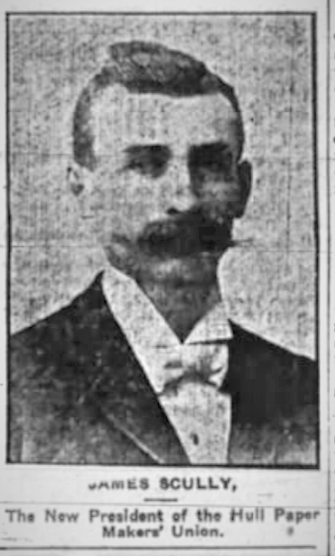 James Scully, President of the Hull Lodge of the International Brotherhood of Papermakers, Ottawa Journal, 13 January 1904.A circular was sent out by James Scully, the president of the Hull branch of the papermakers’ union, and Harry Smith, the union’s secretary, seeking the support of organized labour. This public letter, which was published in the Ottawa Journal, was endorsed by P.M. Draper and C.S.O. Boudreault, the president and secretary, respectively, of the Allied Trades and Labour Council of Ottawa. Its authors wrote that Eddy had “without any regard for the severity of a bitter Canadian winter turned out his employees to suffer, or to die.” They also claimed that the attitude of Eddy had “opened the eyes of all, that certain capitalists take no concern in the material interests of their employees, but seek one and only one thing, their own wealth and the satisfaction of a greed for money.”
James Scully, President of the Hull Lodge of the International Brotherhood of Papermakers, Ottawa Journal, 13 January 1904.A circular was sent out by James Scully, the president of the Hull branch of the papermakers’ union, and Harry Smith, the union’s secretary, seeking the support of organized labour. This public letter, which was published in the Ottawa Journal, was endorsed by P.M. Draper and C.S.O. Boudreault, the president and secretary, respectively, of the Allied Trades and Labour Council of Ottawa. Its authors wrote that Eddy had “without any regard for the severity of a bitter Canadian winter turned out his employees to suffer, or to die.” They also claimed that the attitude of Eddy had “opened the eyes of all, that certain capitalists take no concern in the material interests of their employees, but seek one and only one thing, their own wealth and the satisfaction of a greed for money.”
Eddy did not take this lying down. He quickly filed a $50,000 law suit for libel against the four signatories of the letter. He also demanded an immediate apology from the Ottawa Journal. The next day, the newspaper complied. While voicing its continued support for the papermakers, the newspaper said that the circular contained a number of false statements which discredited the union. The newspaper offered an abject apology to the company and in particular to Mr. Eddy. The Ottawa Citizen exulted that its competitor had to eat “a generous sized dish of crow.”
Using six non-union workers, Eddy got one of his great paper-making machines working within just a couple of days of the start of the lock-out. Within a few weeks, all seven of its machines were up and running. By mid February 1904, sufficient paper was being produced that Eddy could meet all his contracts.
Many of the company’s former employees drifted away, some to the shanties in the woods cutting timber. In late April 1904, the Hull Lodge, No. 35 of the International Brotherhood of Papermakers threw in the towel. A resolution of its members, signed by James Scully and Harry Smith, said that the fight for shorter work hours had been discontinued. Moreover, they asked that “any hard feeling that may have arisen through this trouble be allowed to drop and the same cordial relations shall exist between your company and your former employees, that existed previous to this trouble.”
It would appear that Eddy subsequently dropped his $50,000 libel suit against Scully, Smith and the leaders of the Allied Trades and Labour Council. Eddy died in early 1906 at the age of seventy-eight.
In June 1913, nine years after the lock-out, the E.B. Eddy Company announced that the two-shift system of eleven and thirteen hours used in its book paper division would be discontinued in favour of three eight-hour shifts. The three-shift system had been adopted a few months earlier for newsprint makers. The company said that it wanted to improve the working conditions of its employees. The three-shift system was exactly what the papermakers had recommended in 1904.
Sources:
Manitoba Free Press, 1904. “Work at Eddy Mill,” 15 January.
Ottawa Citizen, 1904. “Eddy Mills Lock Out,” 11 January.
——————, 1904. “Dramatic Interview With the Employes (sic),” 20 January.
——————, 1904. “Eddy Paper Makers’ Strike,” 25 January.
——————, 1904. “Severe on Mr. Eddy,” 25 January.
——————, 1904. “Writ For Damages,” 8 February.
——————, 1904. “The Hull Strike,” 16 February.
——————, 1904. “On The Timber Limits,” 22 February.
——————, 1913. “Gets Three-Eight-Hour Shifts,” 29 May.
Ottawa Journal, 1904. “Lockout At The Big Eddy Paper Mills,” 11 January.
——————-, 1904. “Ultimatum To Paper-Makers,” 13 January.
——————-, 1904. “The Eddy Company Start One Machine,” 14 January.
——————-, 1904. “Men Did Not Heed The Company’s Ultimatum,” 18 January.
——————-, 1904. “Still For Open Shop,” 19 January.
——————-, 1904. “Eddy Strike Not Settled,” 21 January.
——————-, 1904. “An Appeal For Assistance,” 1 February.
——————-, 1904. “The Eddy Strike,” 3 February.
Vancouver Daily World, 1904. “Eddy Will Sue Labor Leaders,” 6 February.
Story written by James Powell, the author of the blog Today in Ottawa's History.
Retired from the Bank of Canada, James is the author or co-author of three books dealing with some aspect of Canadian history. These comprise: A History of the Canadian Dollar, 2005, Bank of Canada, The Bank of Canada of James Elliott Coyne: Challenges, Confrontation and Change,” 2009, Queen’s University Press, and with Jill Moxley, Faking It! A History of Counterfeiting in Canada, 2013, General Store Publishing House, Renfrew, Ontario. James is a Director of The Historical Society of Ottawa.
Phil Jenkins: Arrested Development
In recent years we’ve enjoyed many presentations by Phil, where he has brought a joyful presence to Ottawa’s past, in story and song, but Phil has a special passion for the old neighbourhood of LeBreton Flats, and it’s hard to tell the story of this community without diving into the troubled waters of this troubled land. Vacant since the late 1960s, there’s a generation of Ottawa residents unaware that a close-knit community once thrived here before it was removed as part of something called “urban renewal”.
Phil has many stories to tell of LeBreton, and he has gathered them together in his iconic book titled An Acre of Time.
LeBreton Flats may not have been some people's idea of a paradise but Phil shares many endearing stories from that lost community, lamenting the missed opportunities to save the neighbourhood, and to warn us of the possible mistakes that could be made in the LeBreton’s future.
Also very enjoyable is Phil's latest book, As I Walked About which you will find on his website, at philjenkins.ca.
Watch the video from Phil Jenkin's HSO presentation on April 14, 2021, via this link.
Arrested Development
If you missed the HSO presentation by Phil Jenkins (or you just want to watch again) check out his recap and reflections on the history of LeBreton Flats in this video from April 14, 2021.
Everybody Out!
18 April 1962
It came without warning; a notice addressed to residents of LeBreton Flats reading “This letter will advise you that on April 18, 1962, the National Capital Commission [NCC] filed a notice of expropriation covering the property at [your address.]” With that, 2,800 residents, along with hundreds of businesses, were obliged to move. They were given two years to relocate. The decision to raze the neighbourhood was taken without public consultations, presumably to avoid land speculation. Even Ottawa’s mayor, Charlotte Whitton, was kept in the dark.
In total, 53 acres of land was forcibly acquired from 240 landlords. The government paid fair market value for the land at a cost of about $17 million. The expropriation was part of a project to redevelop the entire LeBreton Flats area of roughly 154 acres. The federal government already owned 60 acres of railway yards and tracks purchased from the Canadian Pacific Railway in an initiative to remove trains from downtown Ottawa. Another 29 acres were to be reclaimed from Nepean Bay, with streets accounting for the remaining 12 acres. The last building to fall to the wrecking ball was the Duke House, the former Couillard Hotel, in October 1965. More than 250 people had crowded into the tavern the previous St Patrick’s Day, its last day in operation, to celebrate its passing. With the Duke House’s demolition, LeBreton Flats, a historic neighbourhood that dated back to the mid 19th century, was nothing but a memory. Its final days were memorialized in oil paintings by local artist Ralph Burton which now hang in the Ottawa City Hall.
The rationale for the expropriation was to eliminate “a real eye sore” of deteriorating housing stock and dirty industry within walking distance of Parliament Hill. The NCC planned to transform the area into something worthy of a national capital, with the construction of up to ten government buildings, along with monuments, parks and parkways. Notwithstanding Prime Minister Diefenbaker’s ambition to complete the project in time for Canada’s centennial on 1 July 1967, Lebreton Flats remained a barren wasteland of weeds, rubble, car parks, and snow dumps for more than 40 years.
There are a myriad of explanations for what went wrong. Changing priorities, cost, recessions, ineptitude, and the discovery of toxins in the soil all played a part in slowing the Flats’ renaissance. The fact that the area was owned for much of the time by three different levels of government, the NCC, the regional government, and the City of Ottawa, didn’t help either.
Many have questioned the original decision by the NCC to bulldoze the Flats, viewing it as a crime committed against the poor. Some look back with nostalgia to a neighbourhood, while hardscrabbled, had a sense of community. But others argue that LeBreton Flats was a gritty, dirty slum. Many of its buildings had been hastily constructed after the 1900 fire which had gutted the area. Only two structures had survived the flames, one ironically being the Couillard Hotel, the last building to demolished in 1965. By the early 1960s, the area was unquestionably rundown, an unhealthy mix of dilapidated houses, scrap yards, metal working plants, mill suppliers, and rail yards. Odours from a paint factory and a brewery poisoned the air.
Regardless of the merits of levelling LeBreton Flats, the fact that the NCC left the brown-field site fallow for more than a generation beggars belief. A succession of proposals was announced for the site with great fanfare only to submerge without a trace. In the late 1960s, the area was to become home of a new headquarters for National Defence. But the three-tower, $40 million project never got off the ground; cost considerations were the likely reason. Instead, National Defence moved to its current location on Colonel By Drive. Subsequent plans for the Flats included a highway interchange with a half-clover leaf, low-cost housing, a convention centre, a national aquarium, a railway terminal for a proposed high-speed train between Windsor and Montreal, and a theme park. While waiting for the NCC to decide, the Flats have been used for special events, including an open-air mass by Pope Jean Paul II in 1984, and performances by the Cirque du Soleil. The land has also been used as a site for hot-air ballooning and as a camping ground.
In the late 1980s, plans for the area focused on five competing concepts with beguiling but obscure names: “Consolidating the Capital,” “Symbolic Bridge,” “A Multi-use Node,” Creating an Urbane Capital,” and “An Agora for the Capital.” Each was assessed on their biophysical, social-cultural, and other characteristics. Under the winning “Agora” concept, the Flats would be populated with museums, offices, roughly 2,500 residential units, of which 1/3 would be social housing, and commercial buildings. There would also be ample green space, including a park (the agora), located in the centre of LeBreton Flats. The Ottawa River Parkway (now Sir John A. Macdonald Parkway) would be relocated to become an urban boulevard through the Flats.
This plan too stalled, in large part on a 1991 environmental study that detailed the various toxins found in the soil and groundwater of LeBreton Flats, a legacy from its industrial past. Before redevelopment could take place, measures would have to be taken to deal with high levels of benzene and other contaminants that had leaked into the soil from the paint factory, underground oil tanks, and waste disposal sites. Snow dumps had also lead to high levels of lead from vehicle emissions, and chloride in the groundwater. Dangerously high levels of methane from rotting household and municipal wastes used as infill were also found in the land reclaimed from Nepean Bay. The cost of remediation and clean-up, which included scrapping off and replacing the topsoil, had risen to more than $70 million by 2012.
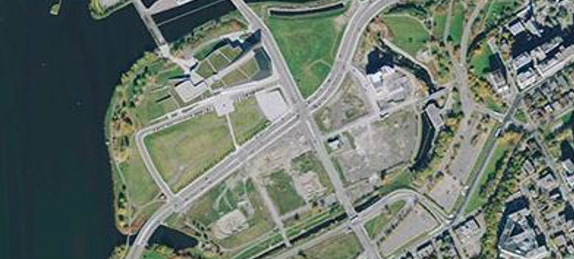 LeBreton Flats, circa2010After more than 40 years of delay, the redevelopment of the LeBreton Flats finally got underway in 2003 with the construction of a new Canadian War Museum. Located close to the Ottawa River, the facility, which cost more than $135 million, opened its doors to the public in 2005. Its environmentally-friendly “green” roof is planted with self-sowing grasses found along the Ottawa River. The fields to the south and east of the Museum are currently used for summer festivals, such as Bluesfest.
LeBreton Flats, circa2010After more than 40 years of delay, the redevelopment of the LeBreton Flats finally got underway in 2003 with the construction of a new Canadian War Museum. Located close to the Ottawa River, the facility, which cost more than $135 million, opened its doors to the public in 2005. Its environmentally-friendly “green” roof is planted with self-sowing grasses found along the Ottawa River. The fields to the south and east of the Museum are currently used for summer festivals, such as Bluesfest.
In 2004, the NCC contacted developers regarding the construction of residential units on a large 11 acre (4.4 hectares) parcel of land. Only three developers, Minto, Alliance Prevel and Claridge, submitted expressions of interest. Controversially, when decision time came, Claridge, judged third on experience and design, was the only contender left standing. The other two had pulled out of the competition owing to changes demanded by the NCC which in their view had made the project nonviable. Since then, Claridge has built two 13-storey condominium towers on LeBreton Flats which some critics panned as “pedestrian.” A third phase consisting of “boutique-style stacked townhomes” is underway.
The LeBreton Flats odyssey is far from over. More residential units are planned though their timing will depend on market demand. The decision to build a light rail transit (LRT) system in Ottawa has also affected development on the Flats. On the positive side, LeBreton Flats will have its own stop, better linking the area to the rest of the city, and increasing its attractiveness to potential residents. On the negative side, the LRT project has prompted the NCC to reassess its approach to the Flats. In September 2014, the Crown Corporation abandoned its twenty-year old plans for mixed-use development for the area saying that they were out-dated and inconsistent with contemporary approaches to development and city needs. It now wants a “signature” attraction of regional, national, or even international significance. Ideas including a downtown hockey arena, or a new site for the Museum of Science and Technology. While the federal government supports this change in direction, it has also indicated that it has no money to finance development. The NCC has invited the private sector to submit proposals for 9.3 hectares of land south of the Parkway and west of Boothe Street. An additional 12.1 hectares might also be made available. The hope is that something could be approved by the NCC Board and the federal government by early 2016.
Sources:
Jenkins, Phil, 2008, An Acre Of Time, Chelsea Books.
McClelland, David, 2009, “The Ottawa Project".
National Capital Commission Planning Branch, Environmental Assessment Section, 1991, LeBreton Flats/Bayview Concept Plans: Initial Environmental Evaluation, Final Report, May.
NCC Watch, The LeBreton Flats.
Ottawa Business Journal, 2012, “Construction crews returning to LeBreton Flats in December,” 29 August.
Ottawagraphy, LeBreton Flats.
Ottawa Sun, 2012, “Cost of Cleaning up Contaminated Soil at Ottawa’s LeBreton Flats would top $71 million, National Capital Commission says,” 22 December.
Rappaport, Michael, LeBreton Flats: Ottawa’s Field of Dreams.
The Ottawa Citizen, 1962, “Huge Expropriation, 10 Gov’t Buildings Planned to”Beautify” Central Area,” 19 April.
———————, 2013, NCC to rethink plans for LeBreton Flats,” 31 August.
——————–, 2014. “Everything you need to know about the NCC’s vision for LeBreton Flats,” 30 September.
The Globe and Mail, 1970, “Paid $1,771,966 for unused HQ Plan,” 20 January.
Trailpeak, 2013, LeBreton Flats, 1950s.
Urbsite, 2010, Ralph Burton on Lebreton Flats.
—————, 2012, Revisiting the Flats after 50 years (and 100, 150, 200 years).
Images:
LeBreton Flats, circa 1960.
LeBreton Flats, circa 2010.
Story written by James Powell, the author of the blog Today in Ottawa's History.
Retired from the Bank of Canada, James is the author or co-author of three books dealing with some aspect of Canadian history. These comprise: A History of the Canadian Dollar, 2005, Bank of Canada, The Bank of Canada of James Elliott Coyne: Challenges, Confrontation and Change,” 2009, Queen’s University Press, and with Jill Moxley, Faking It! A History of Counterfeiting in Canada, 2013, General Store Publishing House, Renfrew, Ontario. James is a Director of The Historical Society of Ottawa.
Jenkins Delights With Stories & Song
Most of our meetings don’t start with a sing-along, but then the guest speaker for our November 2019 meeting is no ordinary presenter.
Phil Jenkins is an author and historian but he’s also a musician who, in addition to his own songs, performs songs by the Beatles — which is fitting considering that most of Phil’s life not lived in Ottawa was spent in Liverpool.
In Phil’s own words, he lived in Ottawa in two shifts. His first was as a child, from 1952 to 1962. He returned to the city in 1978, and has lived in the Ottawa area ever since.
After welcoming the audience, Phil picked up his guitar and started the show by singing a song about the first voyage on the Rideau Canal in 1832, as seen through the eyes of Colonel John By’s 11 year-old daughter, Harriet.
Childhood was the theme of Phil’s presentation. He remembers downtown Ottawa in the 1950s when trains still stopped at the station across from the Château Laurier, and the tallest building was the Peace Tower.
Phil remembers when Rideau Street was “alive with action”. Now he laments that Rideau, after a period as a failed transit mall, has become “homogenized”. The buildings used to have their own individuality. Now they all look the same.
 Author and musician, Phil Jenkins was the HSO's guest speaker on November 14, 2019.
Author and musician, Phil Jenkins was the HSO's guest speaker on November 14, 2019.
Penguin Random House Canada.Sparks Street has met a similar fate. Phil remembers when it was first turned into an innovative pedestrian mall, when he was a child. When Phil returned to Ottawa in his late 20s, the mall had lost its vitality.
Not that he dwells on the negative. He does comment on how we could have done better, and warns us not to repeat past mistakes, but his presentation was very much a positive one.
One change for the better is Ottawa’s growing diversity. Phil observed “Ottawa was very British” when he was young. Now, judging by the variety of restaurants alone, Ottawa has become a better place because of its diversity.
But diversity is not new. Phil reminded us that Ottawa has always been more than just English and French, but that we lost diversity along the way. To emphasize this point, he told us of an Algonguin hunter, Constant Penency, who in his later years had to plead to retain hunting lands sold without his consent. The story is told in more detail in Phil’s book An Acre of Time.
On a more recent topic, Phil took a wry look at our recently-opened Confederation Line and its short, troubled history. Light Rail Transit is not Ottawa’s first streetcar line, he noted. Phil remembers riding the orange-hued streetcars, and told the story of the time as a young lad when he thought he was boarding the trolley back to LeBreton Flats only to wind up in New Edinburgh.
We won’t tell too many of Phil’s stories here. Better to read them in Phil’s own words in his books. In addition to An Acre of Time, Phil has published Beneath My Feet, Fields of Vision, and River Song.
Phil’s history is really a collection of memories of life. An Acre of Time focuses on his recollections of Ottawa; some good, like the aqueduct at LeBreton Flats where he played as a young boy, and some not so good, like the demolition of many historic buildings and the uninspired towers that are now replacing them.
Phil has a skill for conjuring memories. Many hands were raised when he asked how many people remember riding the streetcars, or going to Rasputin’s on Bronson Avenue. The coffee house was the best place in the capital to enjoy folk music.
A lover of folk music, Phil ended the evening with another song; this time about the Great Fire of 1900. The song is not about the details of the event. It’s more about how the fire affected the families in LeBreton Flats and how they rose, so to speak, from the fire’s ashes.
Phil’s songs and stories are a reminder that even in Ottawa, people make history, not politicians.



